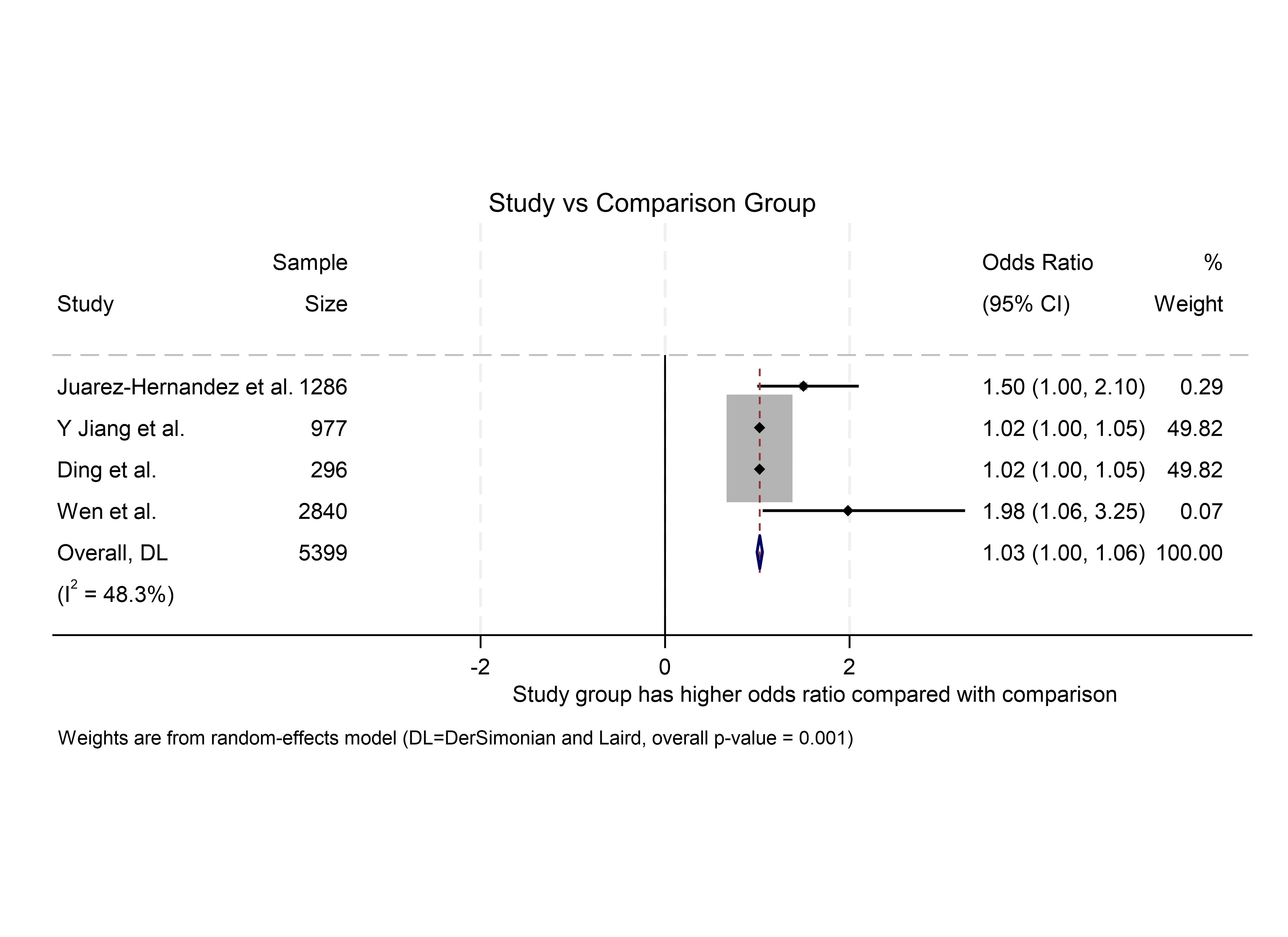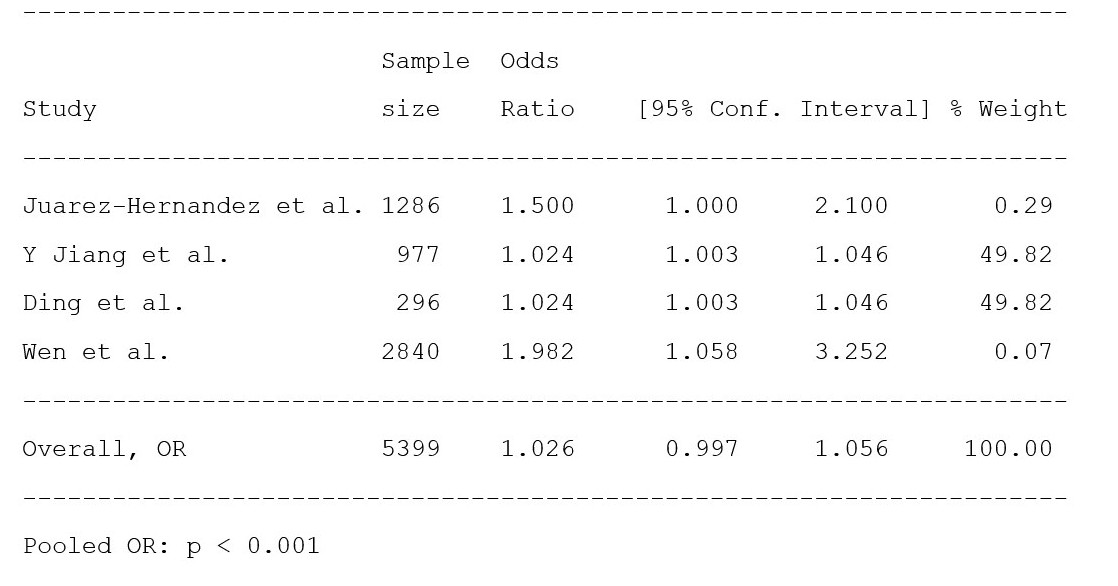Sunday Poster Session
Category: Liver
P1643 - A Systematic Review and Meta-Analysis of Association of Hemoglobin With Metabolic Dysfunction-associated Steatotic Liver Disease (MASLD)
Sunday, October 26, 2025
3:30 PM - 7:00 PM PDT
Location: Exhibit Hall

Harini Rathinamanickam, MD (she/her/hers)
Geisinger Commonwealth School of Medicine
Danville, PA
Presenting Author(s)
Harini Rathinamanickam, MD1, Ying Ying Hu, MD2, Albert Bothchway, PhD2, Maria Yataco, MD3
1Geisinger Commonwealth School of Medicine, Danville, PA; 2Southern Illinois University, Springfield, IL; 3Mayo Clinic, Jacksonville, FL
Introduction: MASLD is the most common form of liver disease worldwide. MASLD has the potential for progression to fibrosis without symptoms. Hence, there is a search for biomarkers for the early diagnosis of MASLD. Studies have found a higher hemoglobin (Hb) in patients with MASLD independent of confounding factors including age, gender, ethnicity, body mass index (BMI), and Diabetes mellitus. These findings suggest that Hb could be a potential biomarker for MASLD. Hence, we chose to conduct a systematic review and meta-analysis of the association between Hb and MASLD.
Methods: The study was registered in PROSPERO (ID =CRD42023479924) and conducted using the PRISMA guidelines. PubMed, Cochrane, Google Scholar, and Cross Reference databases were searched until November 15th, 2023. Inclusion criteria were studies comparing Hb levels in MASLD and non-MASLD patients that had an odds ratio (OR) available. Exclusion criteria were studies in pregnant women, studies that did not compare Hb levels in MASLD and non-MASLD populations, and studies where OR was not provided. Meta-analysis was performed using Stata version 17 (Stata Corp, College Station, TX) software.
Results: Search of above listed databases yielded 13 studies that evaluated hematological parameters in MASLD. Of these 4 studies met the inclusion criteria. This included 2 cross-sectional, 1 retrospective and 1 prospective cohort study. A total of 2011 MASLD (mean age of 44, 72.87% men) and 3388 Non MASLD patients (mean age of 40, 51.4% men) were included in the analysis. Overall, compared to non-MASLD, patients with MASLD had higher Hb with OR 1.026 [95% CI 0.997-1.056], p < 0.001 and I2=48.3%. Mean Hb in patients with MASLD is 14.92 g/dL, and in non-MASLD is 14.005 g/dL.
Discussion: Our study showed that MASLD patients had higher Hb compared to non-MASLD patients. It is unclear if higher Hb is an effect or a cause of MASLD. Mechanisms for MASLD as a cause of higher Hb are: Insulin resistance associated with MASLD could cause higher Hb; MASLD related fat toxicity and physical extrusion of Hb could cause hypoxia. Hepatocellular steatosis related sinusoidal distortion could lead to tissue hypoxia, triggering erythropoiesis. Since Hb is an iron-containing metalloprotein, its levels correlate with iron levels. Increased iron and Hb could lead to oxidative stress, which could lead to MASLD. This is a proposed mechanism for MASLD as an effect of higher Hb. Further studies are needed to elucidate the pathogenesis of increased Hb in MASLD.

Figure: Forest plot of meta-analysis.

Figure: Meta-analysis results.
Disclosures:
Harini Rathinamanickam indicated no relevant financial relationships.
Ying Ying Hu indicated no relevant financial relationships.
Albert Bothchway indicated no relevant financial relationships.
Maria Yataco indicated no relevant financial relationships.
Harini Rathinamanickam, MD1, Ying Ying Hu, MD2, Albert Bothchway, PhD2, Maria Yataco, MD3. P1643 - A Systematic Review and Meta-Analysis of Association of Hemoglobin With Metabolic Dysfunction-associated Steatotic Liver Disease (MASLD), ACG 2025 Annual Scientific Meeting Abstracts. Phoenix, AZ: American College of Gastroenterology.
1Geisinger Commonwealth School of Medicine, Danville, PA; 2Southern Illinois University, Springfield, IL; 3Mayo Clinic, Jacksonville, FL
Introduction: MASLD is the most common form of liver disease worldwide. MASLD has the potential for progression to fibrosis without symptoms. Hence, there is a search for biomarkers for the early diagnosis of MASLD. Studies have found a higher hemoglobin (Hb) in patients with MASLD independent of confounding factors including age, gender, ethnicity, body mass index (BMI), and Diabetes mellitus. These findings suggest that Hb could be a potential biomarker for MASLD. Hence, we chose to conduct a systematic review and meta-analysis of the association between Hb and MASLD.
Methods: The study was registered in PROSPERO (ID =CRD42023479924) and conducted using the PRISMA guidelines. PubMed, Cochrane, Google Scholar, and Cross Reference databases were searched until November 15th, 2023. Inclusion criteria were studies comparing Hb levels in MASLD and non-MASLD patients that had an odds ratio (OR) available. Exclusion criteria were studies in pregnant women, studies that did not compare Hb levels in MASLD and non-MASLD populations, and studies where OR was not provided. Meta-analysis was performed using Stata version 17 (Stata Corp, College Station, TX) software.
Results: Search of above listed databases yielded 13 studies that evaluated hematological parameters in MASLD. Of these 4 studies met the inclusion criteria. This included 2 cross-sectional, 1 retrospective and 1 prospective cohort study. A total of 2011 MASLD (mean age of 44, 72.87% men) and 3388 Non MASLD patients (mean age of 40, 51.4% men) were included in the analysis. Overall, compared to non-MASLD, patients with MASLD had higher Hb with OR 1.026 [95% CI 0.997-1.056], p < 0.001 and I2=48.3%. Mean Hb in patients with MASLD is 14.92 g/dL, and in non-MASLD is 14.005 g/dL.
Discussion: Our study showed that MASLD patients had higher Hb compared to non-MASLD patients. It is unclear if higher Hb is an effect or a cause of MASLD. Mechanisms for MASLD as a cause of higher Hb are: Insulin resistance associated with MASLD could cause higher Hb; MASLD related fat toxicity and physical extrusion of Hb could cause hypoxia. Hepatocellular steatosis related sinusoidal distortion could lead to tissue hypoxia, triggering erythropoiesis. Since Hb is an iron-containing metalloprotein, its levels correlate with iron levels. Increased iron and Hb could lead to oxidative stress, which could lead to MASLD. This is a proposed mechanism for MASLD as an effect of higher Hb. Further studies are needed to elucidate the pathogenesis of increased Hb in MASLD.

Figure: Forest plot of meta-analysis.

Figure: Meta-analysis results.
Disclosures:
Harini Rathinamanickam indicated no relevant financial relationships.
Ying Ying Hu indicated no relevant financial relationships.
Albert Bothchway indicated no relevant financial relationships.
Maria Yataco indicated no relevant financial relationships.
Harini Rathinamanickam, MD1, Ying Ying Hu, MD2, Albert Bothchway, PhD2, Maria Yataco, MD3. P1643 - A Systematic Review and Meta-Analysis of Association of Hemoglobin With Metabolic Dysfunction-associated Steatotic Liver Disease (MASLD), ACG 2025 Annual Scientific Meeting Abstracts. Phoenix, AZ: American College of Gastroenterology.
